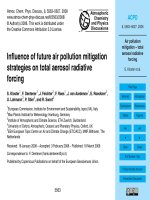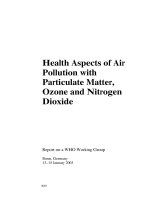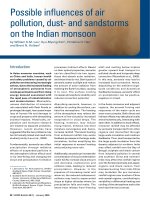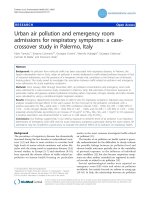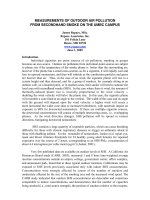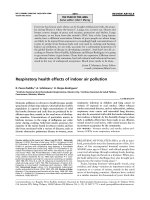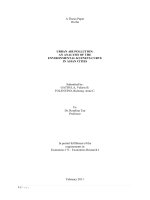PUBLIC PERCEPTIONS OF URBAN AIR POLLUTION WITH A FOCUS ON DEVELOPING COUNTRIES potx
Bạn đang xem bản rút gọn của tài liệu. Xem và tải ngay bản đầy đủ của tài liệu tại đây (245.47 KB, 32 trang )
The East-West Center is an education and research
organization established by the U.S. Congress in 1960
to strengthen relations and understanding among
the peoples and nations of Asia, the Pacific, and the
United States. The Center contributes to a peace-
ful, prosperous, and just Asia Pacific community by
serving as a vigorous hub for cooperative research,
education, and dialogue on critical issues of common
concern to the Asia Pacific region and the United
States. Funding for the Center comes from the U.S.
government, with additional support provided by
private agencies, individuals, foundations, corpora-
tions, and the governments of the region.
East-West Center Working Papers are circulated for
comment and to inform interested colleagues about
work in progress at the Center.
For more information about the Center or to order
publications, contact:
Publication Sales Office
East-West Center
1601 East-West Road
Honolulu, Hawai‘i 96848-1601
Telephone: 808.944.7145
Facsimile: 808.944.7376
Email:
Website: www.EastWestCenter.org
EAST-WEST CENTER WORKING PAPERSEAST-WEST CENTER WORKING PAPERS
EAST-WEST CENTER WORKING PAPERSEAST-WEST CENTER WORKING PAPERS
EAST-WEST CENTER WORKING PAPERS
Environmental Change, Vulnerability, and Governance SeriesEnvironmental Change, Vulnerability, and Governance Series
Environmental Change, Vulnerability, and Governance SeriesEnvironmental Change, Vulnerability, and Governance Series
Environmental Change, Vulnerability, and Governance Series
No. 65, October 2007
Sumeet Saksena is a Fellow in the Research Program at the
East-West Center. He is also Affiliate Faculty at the
Department of Urban And Regional Planning, University of
Hawai`i at Manoa. He has a Ph.D. in Environmental Science
and Engineering from the Indian Institute of Technology
Bombay, India. He has been a member of review committees
of the World Health Organization; Committee on Indoor
Environment Quality, United States Department of Energy;
Advisory Group for the Millennium Ecosystem Assessment;
Standing Research Advisory Committee for the Central
Statistical Organization; and the Technical Working Group,
Cities 21 Pilot Project, International Council for Local
Environmental Initiatives. His important publications
include: Domestic Environment and Health of Women and
Children, Development of Environment Statistics in
Developing Asian and Pacific Countries, Policy Uses of
Particulate Exposure Estimates, Total Exposure as the Basis
of Economic Valuation of Air Pollution in India, Indoor Air
Pollution (in Health and Air Pollution in Rapidly Develop-
ing Countries).
East-West Center Working Papers: Environmental Change,
Vulnerability, and Governance Series is an unreviewed and
unedited prepublication series reporting on research in
progress. The views expressed are those of the authors and
not necessarily those of the Center. Please direct orders and
requests to the East-West Center's Publication Sales Office.
The price for Working Papers is $3.00 each plus shipping and
handling.
Public Perceptions of Urban
Air Pollution with a Focus on
Developing Countries
Sumeet Saksena
1
Public perceptions of urban air pollution with a focus on developing countries
Abstract
Understanding public perception and attitudes toward air quality and regulation is critical
for successful citizen involvement as shifts toward new technologies and management
alternatives take place. While urban air pollution continues to be a major risk in most
parts of the world, very few studies and surveys have been conducted to systematically
study public perceptions related to air pollution. Even fewer studies have focused on
developing countries. This gap is critical because of the complex interaction between
poverty, livelihoods and sustainable development in developing countries. A Pressure-
State-Response framework is used to review studies of public perceptions of air pollution
and knowledge gaps are identified. The paper highlights unique characteristics of urban
areas in developing countries in the context of air pollution related perceptions.
Background
The World Health Organization (WHO) surveyed air quality in cities around the globe
(WHO 2006). The study found the highest levels of air pollution in mega-cities of
developing countries, while air quality in developed countries, notably Japan and the
United States, was improving. The harmful effects of economic growth often occur in the
early stages of development. As a country makes initial investments in basic production
and physical infrastructure, it pays less attention to the deleterious effects of that
investment on environmental quality. As the country develops further, however, the
structure of its economy shifts in ways that expand the size of the middle class. This
2
expansion may change consumer preferences and create attitudes favorable towards
improvement of environmental quality. Together, these shifts may enable developing
countries to afford the purchase of advanced and cleaner technologies from developed
nations (Arrow, Bolin, Costanza, et al., 1995).
Understanding public perception and attitudes toward air quality and regulation will be
critical for successful citizen involvement as these shifts toward new technologies and
management alternatives take place. Most existing studies of environmental concern tend
to be focused on North America, Europe, and Japan. In 1992, Dunlap, Gallup, and
Gallup, conducted the Health of the Planet (HOP) survey, the most comprehensive study
to date, interviewing 30,000 citizens in 24 countries with representative samples and back
translation procedures. The HOP was one of the few studies that enabled cross-country
comparison of results between developed and developing countries. The HOP study
came to the following conclusion: “Environmental problems are salient and important
issues in both wealthy and poor nations and residents of poor nations express as much
concern about environmental quality as do those living in wealthy nations.” (Dunlap,
Gallup and Gallup 1993). They used a very broad definition of environment “ your
surroundings – both the natural environment - the air, water, land, and plants and animals
– as well as buildings, streets, and the like.” The researchers concluded that
environmental quality is no longer seen as a post-materialist value and that environmental
degradation is increasingly recognized as a direct threat to human health and welfare
(Dunlap, Gallup and Gallup 1993; Dunlap and Mertig 1997). However, this study did not
3
offer insights regarding the differences in perceptions and behavior between the poor and
rich within a country.
Recent times have seen an increased research interest in the field of ‘risk perception’
(Slovic 2000). However, only few studies have studied the public perceptions of risk
associated with urban air pollution (defined here as excluding issues such as climate
change, indoor air pollution, noise and radiation). The earliest studies of people’s
perceptions and attitudes regarding air pollution were conducted in the 1950s-1960s in
the USA using social survey techniques (for example, Smith, Schueneman and Zeidberg
1964; de Groot 1967; Shusky 1966, Johnson, Allegre, Burhrman, et al. 1972, Crowe
1968). These studies had a practical aim: to measure the level of awareness among people
about air pollution. The methodologies used is these studies were highly quantitative –
questionnaires and opinion polls. These studies did not examine if, for example,
awareness varied across social groups and time. Therefore the studies revealed a high
variability and inconsistency in findings. For example the awareness about the source of
pollution differed depending on whether an individual had a direct perceptual experience
or media exposure. During the 1970s and 1980s very few studies were conducted,
perhaps because governments in developed countries had seriously begun to formulate
policies and implement laws. The public and researchers began paying more attention to
other environmental problems such as acid rain, global warming, pesticides, etc.
There was a renewed interest in research on air pollution related perceptions in the 1990s
using qualitative methods. The approaches recognized the role of politics and culture in
4
influencing perceptions as well as the inconsistencies in how people act and think. During
the same time new evidence had emerged about the effects of air pollution, especially
fine particulate matter, on human health. Air pollution was back on the political agenda.
However, at least in the more developed countries, the pollutants of concern had changed.
The more easily sensible (visual and odorous) pollution associated with power plants and
industries was replaced by a range of pollutants that were less sensible. A common policy
response was expanding monitoring networks with highly sophisticated instruments.
Information technologies such as the Internet and Geographical Information Systems
(GIS) have greatly facilitated the communication of results and forecasts from these
networks.
The recent studies can be categorized as a) those which have a practical aim to improve
official risk communication (Howell, Moffat, Bush, et al. 2003; Beaumont, Hamilton,
Machin et al. 1999; Cole, Pengelly, Eyles, et al. 1999) and b) those which focus on how
social and cultural factors influence perceptions (Bickerstaff 1999; Bickerstaff and
Walker 1999; Bush, Moffatt and Dunn, 2001a; Bush, Moffatt and Dunn, 2001b; Bailey,
Yearley and Forrester, 1999).
Existing knowledge
The Pressure-State-Impact-Response framework (OECD 1993) is used to examine the
literature on perceptions related to the air pollution problem (see Figure 1). Pressure
represent the social, economic, ecological and institutional driving forces that cause the
emissions. State represents physical, chemical and biological changes in the state of the
5
biosphere. Impact represents social, economic, ecological and institutional impacts of
pollution. Response represents human interventions in response to the societal impacts.
‘Pressure’: Perceptions about the causes and sources of air pollution
Research findings have shown that people largely perceive automobiles as the major
source of pollution (Jacobi 1994; Bickerstaff 1999; Howell, Moffat, Bush, et al. 2003).
However, Bickerstaff (1999) has suggested that not all automobiles are viewed equally –
more blame is assigned away from an individual to ‘other’ polluters such as buses and
other commuters. Bickerstaff suggests that this is the way an individual absolves oneself
(and his or her lifestyle) of direct blame. Industry is also often identified as a significant
polluter (Howell, Moffat, Bush, et al. 2003; Bickerstaff 1999). The role of temporal and
historical issues has been shown to be important. Also, the type of industry and past
associations about an industrial area has been suggested as powerful determinants of
perceptions. Winneke and Kastka (1987) observed a positive attitude towards a chocolate
factory compared to a brewery or a tar oil refinery. Bush, Moffatt and Dunn (2001a) and
Irwin, Simmons and Walker (1999) observed that perceptions were influenced by
community memories of incidents sometimes passed over long periods of time.
Perceptions about the main contributors to pollution were found to vary across socio-
economic groups (Jacobi 1994). In Kuwait people identified air pollution to be the fifth
most important consequence of traffic congestion out of eight possible consequences. But
few parents were willing to use a free school bus service if provided (Koushki, Al-
Fadhala, Al-Saleh and Aljassar 2002).
6
‘State’: Perceptions about the level of air pollution
Studies have stressed the role of practical everyday experience in how people perceive
the quality of air. Most studies have highlighted the role of vision (Howell, Moffat, Bush,
et al. 2003; Bickerstaff and Walker 2001; Bickerstaff 1999; Malm, Leiker and Molenar
1980). These studies suggest that people are concerned about the potential for pollution to
cross political, social and personal borders. Sensory visual perception of air pollution
appears to increase with higher concentrations of suspended particulates within certain
size ranges (Schusky 1966) and with greater dustfall (Stalker and Robinson 1967). In
addition to vision, other forms of sensory awareness were important, such as olfactory
evidence (Mukherjee 1993; Wakefield, Elliot, Cole et al. 2001; Clarenburg 1973) and the
experience of physiological or psychic affects. In an Austrian study, although air
pollutant levels complied with World Health Organization guidelines, there was a
perception of a problem because of odorous fumes, visible dust, and preexisting
symptoms such as fatigue, eye irritation, recurrent colds, etc. (Lercher, Schmitzberger
and Kofler 1995).
It has been shown that people form perceptions about the level of pollution from the
density of presumed sources (cluster of industries, congested road) or other observable
effects of air pollution on the wider environment (color and growth of vegetation)
(Howell, Moffat, Bush, et al. 2003; Bickerstaff and Walker 2001a). It has also been
observed that local knowledges, as obtained through social interactions, play an
important role in the shaping of perceptions (Howell, Moffat, Bush, et al. 2003). Studies
have suggested that lifestyle factors such as time spent outdoors can influence
7
perceptions. Thus, younger people who have an active outdoors life have a greater
concern for air quality than older people who lead comparatively sedentary lives indoors
(as mentioned in Flachsbart and Phillips 1980).
Not much work has been done to study how human perceptions correlate with physical
measurements of pollution. This is an important question, because it would explain why
experts, who rely more on physical data, perceive problems differently from the general
public. Malm, Leiker and Molenar (1980) found a linear relationship, independent of
demographic background, between human perception of visual air quality and physical
indicators such as color and contrast in a landscape. Flachsbart and Phillips (1980) used
physical data for a variety of air pollutants and weather indicators and, more importantly,
for a variety of averaging times and tested the correlation with indicators of perceived
and desired air quality. They discovered that as compared to other pollutants (for all time
frames), levels of ozone and visibility were more correlated with perceived air quality.
Their study suggested that people based their perceptions on the quality of air they
experienced over a long period of time. Short term variations of all pollutants except
ozone, carbon monoxide and visibility (as a surrogate indicator of pollution) were
unlikely to influence perceptions. An important observation, consistent with previous
studies and intuition was that human perception depends on baseline conditions. That is,
people who are accustomed to relatively poor air quality may be less sensitive to further
degradations of air quality. This is important to remember in the context of prevailing
conditions in developing countries. This study defined four measures of human response
to air quality – perception, preference, satisfaction and salience and examined the
8
relationships between the four measures. The study raised important questions such as
“Does the preference for clean air influence one’s perception of reality, such that one
begins to perceive clean air?” Finally, they observed that factors such as ethnicity/race
and income influenced perceptions. Air quality was valued less by those with more
pressing problems.
Despite the increased efforts by governments to provide air quality information services,
recent studies show a) a very low level of awareness and use of these services and b)
skepticism about the motivation of the information providers (Howell, Moffat, Bush, et
al. 2003; Bush, Moffatt and Dunn 2001b; Bickerstaff and Walker 1999). Highly technical
terms and jargons made the information seem irrelevant to people. The issue of spatial
scale is important too – people cannot relate to regional or national statistics, but demand
local statistics (Howell, Moffat, Bush, et al. 2003). Often data published by governments
seems contrary to people’s own perception (Cole, Pengelly, Eyles, et al. 1999; Yearley
1999; Yearly 2000; Bickerstaff and Walker 1999; Bailey, Yearley and Forrester 1999).
Based on a case study and survey in the north west region of the United Kingdom
researches cautioned that the lack of well-grounded methodology and guidance for
handling and representing spatial aspects (using tools such as GIS) of air quality data sets
fosters ambiguity in public perceptions (Lindley and Crabbe 2004). Not surprisingly, air
quality awareness programs had a greater impact on well educated people than on the less
educated, implying the need to supplement such programs with special efforts directed at
the less educated (Stieb, Paola and Neuman 1996).
9
Though it is recognized that perceptions about the general environment are being
increasingly influenced by non-official modes of communication such as television,
literature and the Internet (Bulkeley 2000; Hannigan 1995; Ungar 2000), not much of this
research is specific to problems of urban air pollution.
A related aspect is how people perceive local versus regional air quality. Both early and
recent studies have shown that people evaluate their local neighborhood differently from
the wider region (Rankin 1969; de Groot 1967; Shusky 1966; Francis 1983; McBoyle
1972; Bickerstaff 1999; Bush, Moffatt and Dunn 2001a). Bush, Moffatt and Dunn
(2001a) found that people did not feel that air pollution was a problem in their
neighborhood but rather associated it with poorer communities living closer to industries.
This is a way some people would disassociate themselves from the problem. However
some research questions were still left unanswered: do residents always disassociate
themselves in this way? If not, why not? (It is possible that in order to get governments
do something in their neighbourood, people may consciously or unconsciously
exaggerate their perception of the problem, especially if they believe that pollution has
crossed into their side of the ‘border’ from other sources). Similarly, social status and
ethnicity have been linked to concern for air pollution, with white suburbanites having
expressed more concern than inner-city blacks (Schusky 1966). This contrasts with the
findings of another study in hispanic communities of El Paso, USA, where poorer people,
as compared to wealthier people, perceived air pollution to be a greater risk (Byrd,
VanDerslice and Peterson 1997).
10
While being aware of air pollution, people in an industrial area of India did not feel it was
a matter of concern because of other problems they faced (Bladen and Karan 1976).
However differences across ethnic groups attributable to cultural, psychological and
philosophical traits were observed. They used a modified version of a standard natural
hazard research questionnaire.
Bickertsaff and Walker (20001a) observed that the tendency to rate one’s neighborhood
differently from a wider region depended on a) their sense of power to take action, and b)
their attachment to the place. Where people are not strongly attached to their
neighborhood their perceptions tend to be more negative about air quality and other
attributes. Such a relationship between perceptions of air pollution and indicators of local
social capital and place attachment were identified by Wakefield, Ellliot, Cole, et al.
(2001) in Canada. Thus perceptions that seem ‘ignorant’ or ‘irrational’ are very likely
related to issues of place, identity, power and control.
Jacobs, Evans, Catalano and Dooley (1984) observed that in addition to actual physical
levels, perceived smog was related to prior undesirable life events and psychological
symptoms and stress. The more stressed people are the more likely they are to be irritated
by pollution.
How people’s perceptions change over time is a neglected area of study. In Toronto,
Canada, it was observed that within a span of a decade air pollution declined as a public
concern as other socioeconomic problems emerged (Dworkin and Pijawka 1982). Gould
11
and Golob (1998) studied how people’s attitudes to cleaner vehicles change over time. In
both these studies the role of mass media was found to be significant.
‘Impact’: Perceptions about the health effects of air pollution
There has been a realization in the recent times that health impacts are a major way by
which people realize the extent of the risks associated with air pollution. However, it has
been observed that here too people’s perceptions tend to be influenced less by
scientifically derived information and more by local and personal experiences (Howell,
Moffat, Bush, et al. 2003; Bickerstaff 1999; Elliot, Cole, Krueger, et al. 1999). It is very
likely that the ‘invisibility’ aspect of air pollution discourages people from drawing
strong links between air pollution and health. Consequently, health problems are
dismissed as being imaginary or causation is attributed entirely or partly to other causes –
climate change, bad housing, pollen, etc. Improvements in public health services and
changes in cultural attitudes towards health care have also been shown to influence
perceptions about the link between pollution and health (Bickerstaff and Walker 2001a).
Perhaps the most interesting observation has been that, like perceptions about the
neighborhood, people related air pollution to ill health in a general way, but only a few
believed that health problems affected them directly (Wall 1973; Bush, Moffatt and Dunn
2001a; Bickerstaff and Walker 2001a). Byrd, VanDerslie, and Peterson (1997) observed
that people across all socio-economic strata felt that air pollution pose a greater risk to the
community as a whole than to the self and family. Thus most do not deny the risks, but
deny its personal effects, possibly to avoid anxiety. Bush, Moffatt and Dunn (2001a)
12
observed that wealthier individuals felt that ill health associated with air pollution was
mainly a problem for poorer individuals living near industries. It is not clear if wealthier
individuals felt that they were less exposed or less vulnerable to exposure or both.
Chattopadhyay, Som and Mukhopadhyay (1995) found that individuals living in
industrial areas complained more about respiratory problems, psychobiological stress and
anxiety than those living in residential areas. This pattern had earlier been observed by
Evans, Jacobs, Dooley, et al. (1987) and Zeidner and Schechter (1988). However, it is not
known if the people themselves are aware that their mental stress can be attributed to air
pollution and more importantly, whether this stress, affects their perceptions about other
aspects of the air pollution problem. Navarro and Simpson-Housley (1987) noted that
individuals in Santiago de Chile with high trait-anxiety were more concerned about air
pollution problems. They suggested that ‘visible’ pollution provides an objective threat.
They also observed that individuals with high trait-anxiety were more likely to personally
undertake anti-pollution measures.
In addition to health effects there are the nuisance and aesthetics impacts of pollution- ‘it
dirties the house’ (Jacobi 1994; Howell, Moffat, Bush, et al. 2003; Bickerstaff and
Walker 2001; Bickerstaff 1999). Dwellers further away from the city center placed more
emphasis on the dirtiness of dust and soot (Jacobi 1994).
13
“Response”: Perceptions about government actions and policies
Very few studies have attempted to assess people’s perceptions about governments’
interventions. Interventions mean either direct mitigative actions or data gathering efforts.
Were these the right interventions? How successful were these interventions in terms of
either process or outputs? McDonald, Hession, Rickard, et al. (2002) found that such
perceptions were largely media influenced. Jacobi (1994) found that respondents felt that
the both the public and private sectors had an equal responsibility to improve the air
quality. However, a reluctance was observed to change individual or community
behavior. No differences were observed across the socio-economic strata regarding
beliefs of what actions need to be taken. In Istanbul respondents felt that local authorities
had more responsibility than federal agencies to do something about the problem
(Kurtulus 1992).
Multi-country studies
Though there are a few cross cultural studies of perceptions of risks, none had considered
air pollution as a risk factor (Jacobs and Worhthley 1999; Keown 1989; Englander,
Farago, Slovic and Fischoff 1986). However, these studies do indicate that for most risks
cultural factors are an important determinant of perceptions of risk.
Comparison with perceptions of other risks
A study conducted in Sao Paulo, Brazil, across six socio-economic strata showed that
overall air pollution was rated the most serious among eighteen environmental related
problems (Jacobi 1994). However, wealthier groups felt it was more of a problem than
14
poorer groups who tended to rate sewage disposal, water quality, etc. as greater problems.
Perceptions regarding sources of pollution varied across socio-economic groups. In
contrast to the Sao Paulo study, a survey in Istanbul ranked air pollution as the second
most important problem after garbage and wastes problem (Kurtulus 1992). This is not
surprising considering that Sao Paulo is one of the most air-polluted cities in the world –
far more than Instanbul. Byrd, VanDerslie, and Peterson (1997) also found that, across all
socio-economic groups in El Paso, USA, people perceived air pollution to be a lesser
risk, to themselves and to the community, compared to other environmental and non-
environmental risks (such as crime, drugs, AIDS, etc.)
The developing countries context
In light of the above review a few characteristics of developing countries are mentioned
that would influence perceptions of air pollution risks and therefore which need to be
kept in mind while designing studies.
In much of the developing world, the urban areas still witness extremely high levels of
both visible (particulate matter) and invisible (gases) forms of air pollution. The high
levels may well yield a ‘saturation’ effect, such that there is little variation in perception
across social and demographic groups. Therefore the framing of right questions is a
crucial task. Also, due to factors such as aridness, topography, etc. the levels of natural
(background) dust are higher than those observed in more developed countries. Therefore
one can speculate that people are more ‘accustomed’ to visible forms of pollution and any
manmade increase in air pollution does not cause as much concern as in other countries.
15
Owing to poverty and literacy levels there is considerably less exposure to mass media.
Therefore personal experiences and social interactions are more likely to play a greater
role in influencing perceptions than the mass media, compared to more developed
countries. Even those who are exposed to mass media may not find much information on
air pollution issues, because journalists, reflecting society’s preoccupation with non-
environmental risks, do not provide adequate coverage.
Poverty, livelihoods and perceptions
Poverty and unemployment is rampant in urban areas of developing countries. Low-
income residents tend to be among the most vulnerable to exposure from environmental
health hazards, they are most susceptible when they are exposed, and the least able to
cope with the consequences. Surveys that have used a broad definition of environment
(not just air pollution) have shown mixed results regarding the relationship between level
of affluence and environmental concern, perception, and response. The literature
regarding urban air pollution has so far not addressed livelihood impacts in a
comprehensive manner. However, the few studies that have examined these relationships
indicate that factors such as socioeconomic status as well as race and ethnicity influence
environmental perception and concern. Mukherjee (1993) sampled 1724 residents of
Calcutta. Respondents with lower education and socio-economic status showed less
awareness and concern in response to air pollution. In the United States, cross-cultural
studies of risk perception and environmental quality have indicated a link between the
social context of risk exposure and environmental concern. Baird (1986) found that
16
community tolerance for the risks presented by a copper smelter plant were influenced by
knowledge, benefits, voluntariness, and environmental attitudes. Respondents showed
variation in the perceived voluntary/involuntary nature of their exposure, with workers at
the plant exhibiting the greatest level of denial in assessing their objective risk. In
addition, people had a tendency to substitute informal risk analysis, based on their own or
family members’ experiences, for formal analysis based on scientific estimates by the
EPA. And their factual knowledge of formal risk estimates or proposed standards did not
reflect their own risk estimates or their desired level of regulatory control.
Early studies finding a positive relationship between income and environmental concern
have suggested that the poor tend to be less concerned about air quality because of one or
more of the following reasons: a) they are accustomed to dirtier environments, b) they
feel they have more pressing problems to attend to, and c) sense of lack of control - they
feel they have little influence over actions and decision makers. In contrast to these
studies carried out in the late 60’s and 70’s, meta-analysis studies have suggested that
response by poor or minority groups is both heterogeneous (Vaughan and Nordenstam
1989), and dependent on the sociopolitical context (Taylor; 2000). The poor will respond
differentially to pollution risks if faced with real or perceived threats to their livelihoods
as a result of laws, programs and actions that governments undertake to manage the air
pollution problem.
Unfortunately, only a few studies have investigated the interface between threats to
livelihood and attitudes and perceptions of air quality and air quality management
17
options. The few cross-national comparative findings on concern for environmental
quality indicate that there is strong growing environmental concern in developing
countries (Dunlap, Gallup and Gallup 1993; Brechin and Kempton, 1994). However,
specific case examples indicate that this environmental concern is also tempered by
perceived and real threats to jobs and livelihood. For example, in New Delhi, three
people died in violent protests by factory owners and workers against new pollution
controls after the Supreme Court ordered authorities to seal polluting industries in
residential areas and cancel their licenses (Reuters, 2000). In a second example, a strike
by tens of thousands of auto rickshaw and taxi drivers in the Indian capital, Delhi, caused
travel chaos for the city’s commuters. Office and factory workers had to find alternative
means of transport as the striking drivers protested against new anti-pollution measures
which, they said, were threatening their livelihoods.
The poor’s heightened level of vulnerability in developing countries is expected to
elevate the level of real or perceived threats to their livelihoods, either as a result of
environmental hazard exposure or because of laws, programs and actions put in to place
to manage the air pollution problem. Examples are mandatory closure or relocation of
factories, taxi drivers giving up their occupation because they cannot afford to install new
control devices or switch to cleaner fuels, daily wagers being affected by strikes
provoked by air pollution regulations, roadside vendors having to relocate because of
road widening projects, etc. In India, small and medium scale industries had to close
down or relocate out of the cities of Agra (in the vicinity of the Taj Mahal) and New
Delhi. In New Delhi, taxi drivers, and private bus operators were required by law to start
18
using natural gas instead of gasoline. Studies have indicated that mere threats to lifestyle
(such as having to switch to car pools) are enough to influence perceptions about air
pollution problems. In particular, future studies should examine the degree to which level
of concern about air pollution changes as a function of the perceived impact of
government regulations.
Threats to livelihoods, especially for the very poor, could mean either a job loss or
increased expenditure. For example, air pollution related actions may result in a hike in
mass transport fare. For the poor, even a minor increase in expense means hardship. The
number of people who rely on mass transport is also very high – in developing Asian
countries 37.8% (54% in Delhi) of workers use mass transit as compared to only 9.0% in
USA (Kenworth and Laube 1999). Alternatively, there may be a belief that ill health
associated with air pollution affects personal productivity at work leading in the extreme
to absenteeism. These are the direct threats. Then there are the indirect threats: people,
even those whose jobs are not threatened, may feel that air pollution programs affect the
economy as a whole and therefore there must be some indirect negative effect on their
well being. This would be most likely to occur if the public also exhibits low levels of
knowledge about the health benefits of air pollution. Higher levels of knowledge by the
public about the causes of environmental degradation are associated with both increased
support for government initiatives and voluntary actions (O’Connor, Bord, Uarnal, and
Wiefek 2002).
19
This review of literature suggests that past studies have not looked in detail at the
relationship between livelihood and perceptions regarding air pollution. How do those
who have lost their jobs/are likely to lose their jobs perceive these problems? How do
people react when they have to pay more for buses, etc.? They may feel that the
government exaggerates the problem. Instead of blaming the industry they may feel that
government is more responsible for their plight because government forced the industries
to shut down. As the examples cited in India suggest, this type of vulnerability threat can
occur on a relatively large scale depending on the type of regulation.
Those who feel they are neither directly nor indirectly affected by job losses may
sympathize with the ‘victims’. But this may depend on whether they think that the person
who lost the job is a ‘source of pollution’ or not. A rich person may sympathize with the
poor workers who lost their job after a polluting factory was shut down, but may not
sympathize with the driver of a smoke belching taxi who stopped his business because he
could not afford to upgrade his taxi. A local authority’s stated intention to prohibit
certain types of new industries may be viewed as negatively affecting the economy.
Bickerstaff and Walker (2002) in their study of public perception of urban air pollution in
Birmingham, UK, identified a number of cognitive patterns in which the individual seeks
to move responsibility for air quality onto other groups.
Past studies have suggested that prior stress and anxiety caused by non-environmental
events can influence the perception of environmental risk. The loss, or potential loss of
one’s job is ranked as one of the highest stress experiences (Castro, Romero and
20
Cervantes 1986). Typically, increasing levels of stress would be expected to correlate
with increasing perceptions of risk, but in this situation, the stressor - job loss - is actually
(or perceived to be) due to air pollution control actions. This may influence both
perceived risk and support for air control measures. Poor daily-wagers may view job
threats due to air pollution as just one of many reasons for the temporary nature of their
job and hence may have less of a negative attitude to the threat. People with more
permanent jobs may tend to have more of a negative attitude. Satterfield, Mertz and
Slovic (2004) found that increased perceptions of vulnerability and injustice resulted in
higher risk rating across a range of hazards.
Knowledge gaps and needed research
From this review of studies it is apparent that much of the work has focused on
perceptions of the state of air quality and the determinants of these perceptions. In the
context of public participation and governance, there is a crucial gap related to public
perceptions of government and policy responses (either past, current or anticipated).
Very few studies have been conducted by inter-disciplinary teams comprising of social
and physical scientists. Cross-cultural comparisons are lacking. If mass media is
important, as some studies have suggested, it is necessary to know how journalists
themselves perceive air quality issues. Longitudinal studies – repeating the same set of
questions with the same individuals regularly over a period of time – have not been
conducted. Barring a couple of studies, there is no information about people’s perceptions
to specific pollutants. It is possible that people view air pollution in an ‘aggregate’ sense,
while experts like to design pollutant specific solutions. While a few studies have studied
21
the variation of perceptions across demographic and socio-economic groups very few
have examined the differences across various stakeholder groups (citizens, small and big
industry, government, unions, activists, journalists, non-governmental think tanks, etc.)
Future studies of perceptions of urban air pollution in developing countries should focus
on sources (e.g. motorcycles, buses, refuse burning, small industries) and pollutants (e.g.
dust) that are comparatively unique and of greater concern in their setting. More
importantly, the effect of poverty and livelihoods related variables on public perceptions
needs greater research attention.
22
Figure 1 Pressure-State-Response Framework
